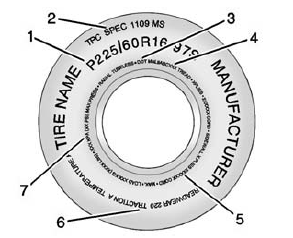Chevrolet Spark Owners Manual: Tire Sidewall Labeling
Useful information about a tire is molded into its sidewall. The examples show a typical passenger tire sidewall.

Passenger (P-Metric) Tire Example
(1) Tire Size: The tire size is a combination of letters and numbers used to define a particular tire's width, height, aspect ratio, construction type, and service description. See the “Tire Size” illustration later in this section for more detail.
(2) TPC Spec (Tire Performance Criteria Specification): Original equipment tires designed to GM's specific tire performance criteria have a TPC specification code molded onto the sidewall.
GM's TPC specifications meet or exceed all federal safety guidelines.
(3) DOT (Department of Transportation): The Department of Transportation (DOT) code indicates that the tire is in compliance with the U.S. Department of Transportation Motor Vehicle Safety Standards.
DOT Tire Date of Manufacture: The last four digits of the TIN indicate the tire manufactured date. The first two digits represent the week (01-52) and the last two digits, the year. For example, the third week of the year 2010 would have a four-digit DOT date of 0310.
(4) Tire Identification Number (TIN): The letters and numbers following the DOT code are the Tire Identification Number (TIN).
The TIN shows the manufacturer and plant code, tire size, and date the tire was manufactured. The TIN is molded onto both sides of the tire, although only one side may have the date of manufacture.
(5) Tire Ply Material: The type of cord and number of plies in the sidewall and under the tread.
(6) Uniform Tire Quality Grading (UTQG): Tire manufacturers are required to grade tires based on three performance factors: treadwear, traction, and temperature resistance. For more information see Uniform Tire Quality Grading on page 10-52.
(7) Maximum Cold Inflation Load Limit: Maximum load that can be carried and the maximum pressure needed to support that load.
 Summer Tires
Summer Tires
This vehicle may come with high performance summer tires. These tires have a
special tread and compound that are optimized for maximum dry and wet road performance.
This special tread and compound ...
 Tire Designations
Tire Designations
Tire Size
The following is an example of a typical passenger vehicle tire size.
(1) Passenger (P-Metric) Tire: The United States version of a metric tire sizing
system. The letter P as the fir ...
Other materials:
If the On Indicator Is Lit for a Child Restraint
If a child restraint has been installed and the on indicator is lit:
Turn the vehicle off.
Remove the child restraint from the vehicle.
Remove any additional items from the seat such as blankets, cushions, seat
covers, seat heaters, or seat massagers.
Reinstall the child restraint follo ...
Exit Lighting
If the dome lamps are in the DOOR position, they come on automatically when the
key is removed from the ignition. The exterior lamps and dome lamps remain on after
the door is closed for a set amount of time, then automatically turn off.
The headlamps, parking lamps, and back-up lamps will turn ...
If the Vehicle Is Stuck
Slowly and cautiously spin the wheels to free the vehicle when stuck in sand,
mud, ice, or snow.
If stuck too severely for the traction system to free the vehicle, turn the traction
system off and use the rocking method. See Traction Control/Electronic Stability
Control on page 9-27.
Warning ...
